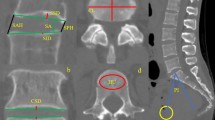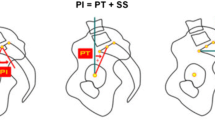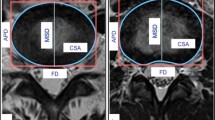Abstract
Summary of background data
The sagittal profile of lumbar endplates is discrepant from current simplified disc replacement and fusion device design. Endplate concavity is symmetrical in the coronal plane but shows considerable variability in the sagittal plane, which may lead to implant–endplate mismatch.
Objective
The aim of this investigation is to provide further analysis of the sagittal endplate morphology of the mid to lower lumbar spine study (L3–S1), thereby identifying the presence of common endplate shape patterns across these levels and providing morphological reference values complementing the findings of previous studies.
Study design
Observational study
Methods
A total of 174 magnetic resonance imaging (MRI) scans of the adult lumbar spine from the digital archive of our centre, which met the inclusion criteria, were studied. Superior (SEP) and inferior (IEP) endplate shape was divided into flat (no concavity), oblong (homogeneous concavity) and ex-centric (inhomogeneous concavity). The concavity depth (ECD) and location of concavity apex (ECA) relative to endplate diameter of the vertebrae L3–S1 were determined.
Results
Flat endplates were only predominant at the sacrum SEP (84.5%). The L5 SEP was flat in 24.7% and all other endplates in less than 10%. The majority of endplates were concave with a clear trend of endplate shape becoming more ex-centric from L3 IEP (56.9% oblong vs. 37.4% ex-centric) to L5 IEP (4% oblong vs. 94.3% ex-centric). Ex-centric ECA were always found in the posterior half of the lumbar endplates. Both the oblong and ex-centric ECD was 2–3 mm on average with the IEP of a motion segment regularly possessing the greater depth. A sex- or age-related difference could not be found.
Conclusion
The majority of lumbar endplates are concave, while the majority of sacral endplates are flat. An oblong and an ex-centric endplate shape can be distinguished, whereby the latter is more common at the lower lumbar levels. The apex of the concavity of ex-centric discs is located in the posterior half of the endplate and the concavity of the inferior endplate is deeper than that of the superior endplate. Based on the above, the current TDR and ALIF implant design does not sufficiently match the morphology of lumbar endplates in the sagittal plane.



Similar content being viewed by others
References
Boszczyk BM, Boszczyk AA, Putz R (2001) Comparative and functional anatomy of the mammalian lumbar spine. Anat Rec 264:157–168
Chen H, Jiang D, Ou Y, Zhong J, Lv F (2011) Geometry of thoracolumbar vertebral endplates of the human spine. Eur Spine J 20:1814–1820
van der Houwen EB, Baron P, Veldhuizen AG et al (2010) Geometry of the intervertebral volume and vertebral endplates of the human spine. Ann Biomed Eng 38:33–40
Pfirrmann C, Metzdorf A, Zanetti M et al (2001) Magnetic resonance classification of lumbar intervertebral disc degeneration. Spine 26:1873–1878
Van Ooij A, Oner FC, Verbout AJ (2003) Complications of artificial disc replacement: a report of 27 patients with the SB Charite disc. J Spinal Disord Tech 16:369–383
Punt IM, Visser VM, van Rhijn LW, Kurtz SM et al (2008) Complications and reoperations of the SB Charite lumbar disc prosthesis: experience in 75 patients. Eur Spine J 17:36–43
Gstoettner M, Heider D, Liebensteiner M, Bach CM (2008) Footprint mismatch in lumbar total disc arthroplasty. Eur Spine J 11:1470–1475
Ravi B, Rampersaud R (2008) Clinical magnification error in lateral spinal digital radiographs. Spine 33:E311–E316
Conflict of interest
None.
Author information
Authors and Affiliations
Corresponding authors
Rights and permissions
About this article
Cite this article
Lakshmanan, P., Purushothaman, B., Dvorak, V. et al. Sagittal endplate morphology of the lower lumbar spine. Eur Spine J 21 (Suppl 2), 160–164 (2012). https://doi.org/10.1007/s00586-012-2168-4
Received:
Accepted:
Published:
Issue Date:
DOI: https://doi.org/10.1007/s00586-012-2168-4




